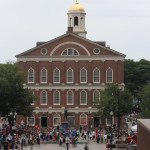The Huguenots were the French Calvinists.
By 1562, their numbers had reached 2,000,000 adherents, mostly in southern and central France. This was about 10% of the French population. Because they were seen by the Catholic Church and many of their fellow countrymen, as schismatics, something worse then heretics, they were prosecuted. There were numerous religious wars between the aristocratic houses, the Catholics fighting those that had converted to Calvinism, between 1562 and 1598. The worse single day in Huguenot history wa s in August of 1572, St. Bartholomew Massacre, when entire towns across the country were burned, and at least 10,000 people were killed. After this Huguenots believed that Catholicism was a bloody treacherous religion.
s in August of 1572, St. Bartholomew Massacre, when entire towns across the country were burned, and at least 10,000 people were killed. After this Huguenots believed that Catholicism was a bloody treacherous religion.
The government and monarchy tried to calm the sectionalism apparent in the religious warsn and in 1598 the Treaty of Nantes was signed by Henry IV. This gave Huguenots the right to worship, and travel through countries controlled by the Inquisition. The Treaty also gave Protestants civil rights, by separating civil from religious law. The Treaty of Nantes was revoked by Henry IV’s grandson Louis XIV, in 1685.
Although it was illegal, many Protestants had their lands stolen and goods confiscated, enduring countless episodes of persecution. Because of this, even before the revocation of the Treaty, thousands of Huguenots fled from France. They brought with them the French love of good tales, food and joie de vivre.
In her book on the history of fashion, Milla Davenport wrote about the Huguenots’ leaving from the perspective of the trades and skills they removed from France.
“The greatest mistake of Louis’ life, the Revocation of the Treaty of Nantes, for which the Church had longed… The Protestants who were among France’s most worthy and industrious citizens were driven to sympathetic neighboring countries; some of the most prosperous districts of France were depopulated and reduced to poverty as weavers, printers, watchmakers and goldsmiths set for England, Switzerland, Alsace, Holland and Germany on the road to rivalry and supremacy in these arts.” The Book of Costume: vol 1., Milla Davenport, Crown Publishers, New York, New York. 1948.
Matilda’s mother, like Boston’s Peter Faneuil and Paul Revere, was a Huguenot . She was born in Boston, the second stop after the family left France. The Huguenot church in London was established the century before, in1550 by the first emigres. As many Calvinists did, Phillipa’s family came to New England in 1660 and settled in Boston. Phillippa married John Huddleston in 1689. Her younger brother moved to New Rochelle, New York to apprentice with an uncle in his trading business, as Peter Faneuil did.
. She was born in Boston, the second stop after the family left France. The Huguenot church in London was established the century before, in1550 by the first emigres. As many Calvinists did, Phillipa’s family came to New England in 1660 and settled in Boston. Phillippa married John Huddleston in 1689. Her younger brother moved to New Rochelle, New York to apprentice with an uncle in his trading business, as Peter Faneuil did.
So with an Englishman, an Agawam, a Marranos and a Huguenot I’ve created the eighteenth American polyglot for my next book, The Silent Bell. Nothing in her captivity is like what Matilda read in her captivity legends, instead the reason for her captivity has its roots not in New France and New England but in a medieval legend, and old hatreds.
Matilda has the key to enable or to destroy the past. If she is not careful her family’s enemy will reclaim their power and she must prevent that by holding her secret tight.
